Bees have an important role in pollination. They provide environmental benefits for Californian crops. Both native and national bee species are found in the state.
It’s estimated there are over 1.000 bee species in California. The following species are the most common among them.
Table of Contents
1. Western Honey Bee
The Western Honey Bee (Apis mellifera) is the most common bee species in California. It plays an important ecological and financial role here.
The species is known to pollinate almonds in California. The problem is that almond pollination happens in February when the Western Honey bee hasn’t yet fully established its colonies.
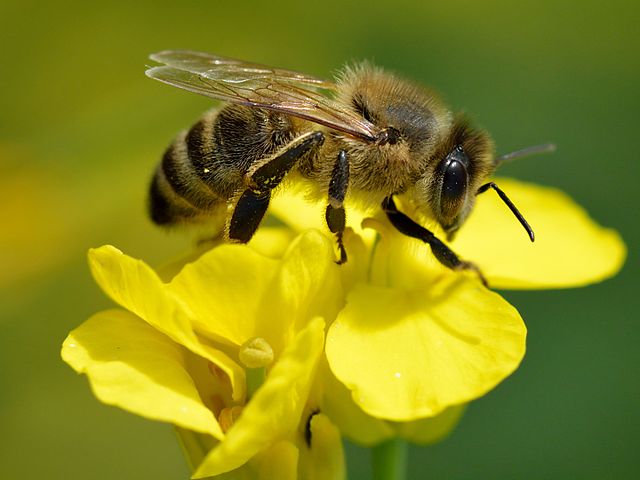
This means many Western Honey Bee colonies have to be brought to California every year from other parts of the country.
It’s estimated this is the largest controlled pollination process in the country. Up to a third of all commercially-available Western Honey Bees are sent over to California during this process.
2. Yellow-faced Bumble Bee

The Yellow-faced Bumble Bee (Bombus vosnesenskii) is also very common in California. This species has been shown to select the habitat it lives in depending on the diversity of the flora it finds there.
Yellow-faced Bumble bees are the most important pollinators of greenhouse tomatoes in California.
It’s estimated their pollination effects are superior to the pollination of tomatoes that humans account for.
Tomatoes grow larger, riper, and with more seeds when pollinated by the Yellow-faced Bumble Bee as opposed to when pollinated by humans.
Scientists don’t know the explanation for their tomato pollination success.
Some theories suggest the success of the Yellow-faced Bumble Bee pollination in tomato greenhouses comes down to timing.
Bees know where the tomato plants are fully ready to be pollinated by counting on an innate pollination clock humans can’t replicate.
3. Black-tailed Bumble Bee
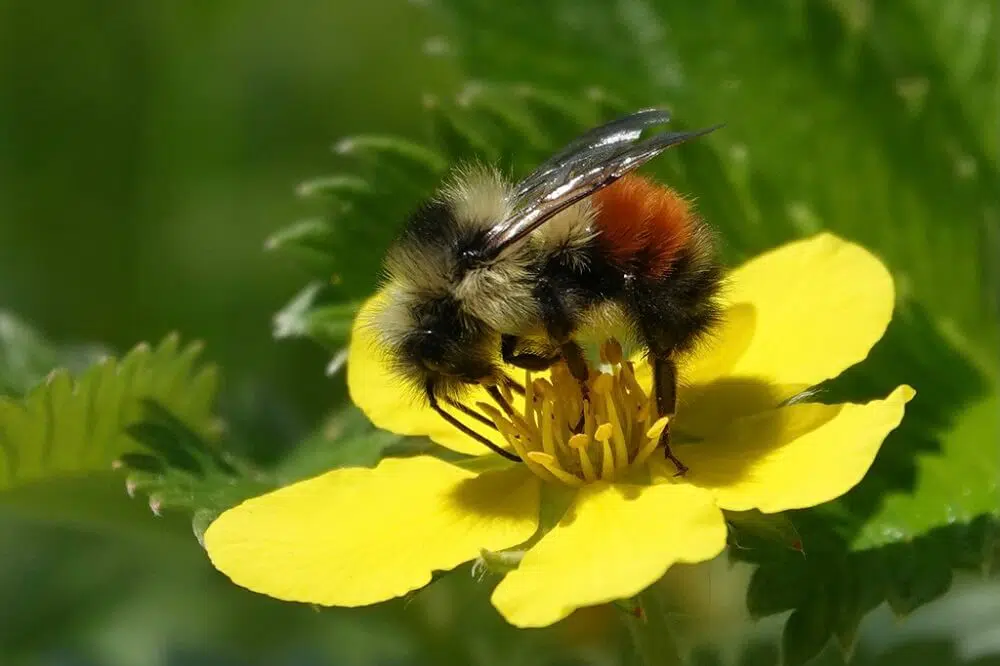
The Black-tailed Bumble Bee (Bombus melanopygus) is common in many areas of California. However, its numbers are dropping around San Francisco where it remains one of the few bumble bees in the area.
This dark-colored bee was once widespread even in the Northern parts of the country.
The Northern and the Southern species arose. The Northern species is known for having red segments on its body while the dark Southern species found in California are all black.
Native to Western North America, the species (together with its Northern counterpart) is found in all states from California to British Columbia in Canada.
In California, the bees can sometimes be spotted around clary, sage, lilac, and manzanitas flowers.
4. Valley Carpenter Bee
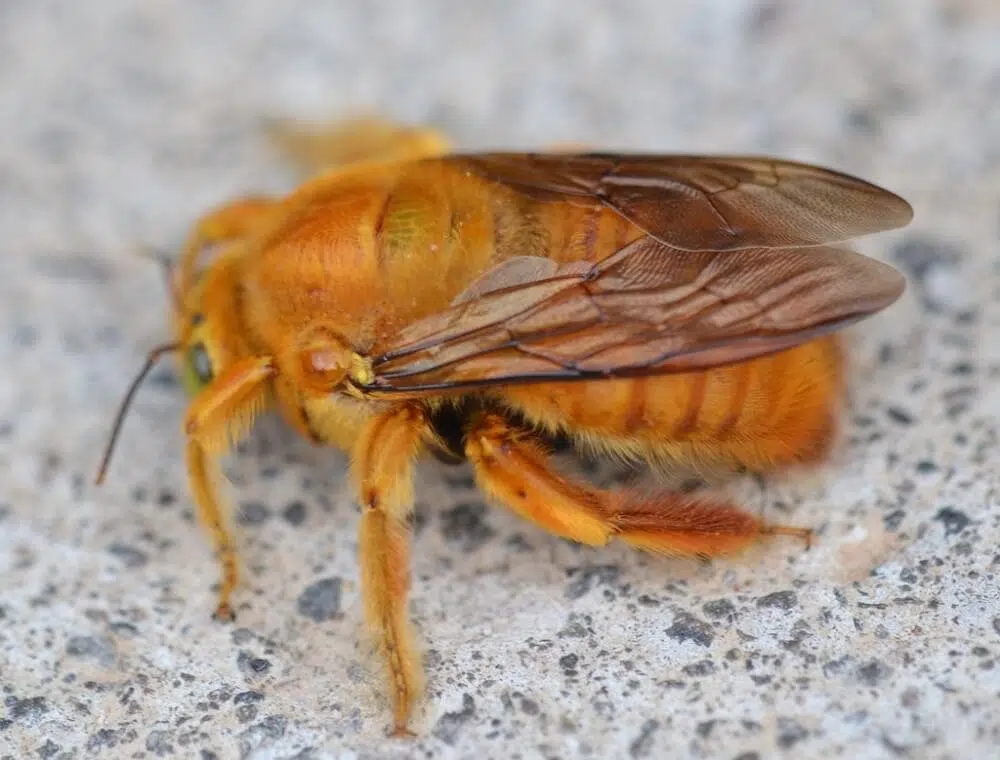
Known for many distinct traits, Velly Carpenter Bees (Xylocopa sonorina) are common in California. The species is known for its territorial habits which means it prefers to forage an area on its own.
Multiple studies have been conducted on this common species. Most agree these bees spend between 1 and 2 seconds on a single flower managing to visit up to 16 flowers without interruption.
It uses both pollen and nectar for feeding its larvae. Offspring are fed early in the spring when females keep on bringing a mixture of pollen and nectar.
Unusual thermoregulation capacity is also characteristic of Valley Carpenter bees. This means these bees can control their body temperature better than other bees.
They can fly at higher temperatures (specific to California) as well as in lower temperatures compared to other bees.
Mating habits are diverse and different in the species as well. Females sometimes wait for males in some of the best flowers where they might be attracted by pollen in the first place.
5. Ligated Furrow Bee
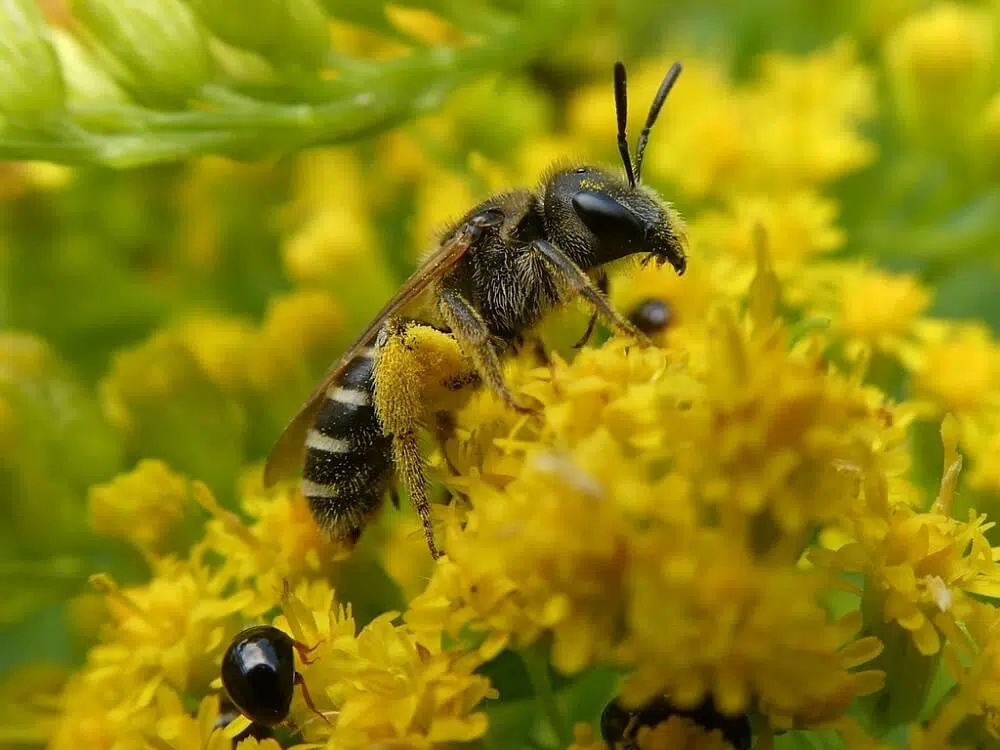
The Ligated Furrow Bee (Halictus ligatus) is known across California and other states. This common Halictidae species is known to live in colonies.
Queens emerge in the spring after months of hibernation. They start digging and setting up colonies. The queens of the Ligated Furrow species are known to be aggressive.
Queen bees suppress the ovarian abilities of other female bees in the colony so that only the queen can lay eggs. The use of pheromones to control this is considered aggressive.
These bees are known for visiting multiple plants and flowers to collect pollen. Like most other bees, they prefer the pollen with the highest protein content.
Bees of the species are known to be dependent on the amount of protein in the pollen as well as on weather conditions to grow to a full size.
Bad weather prevents proper pollen collection which means young bees don’t get sufficient protein to grow.
6. California Bumble Bee
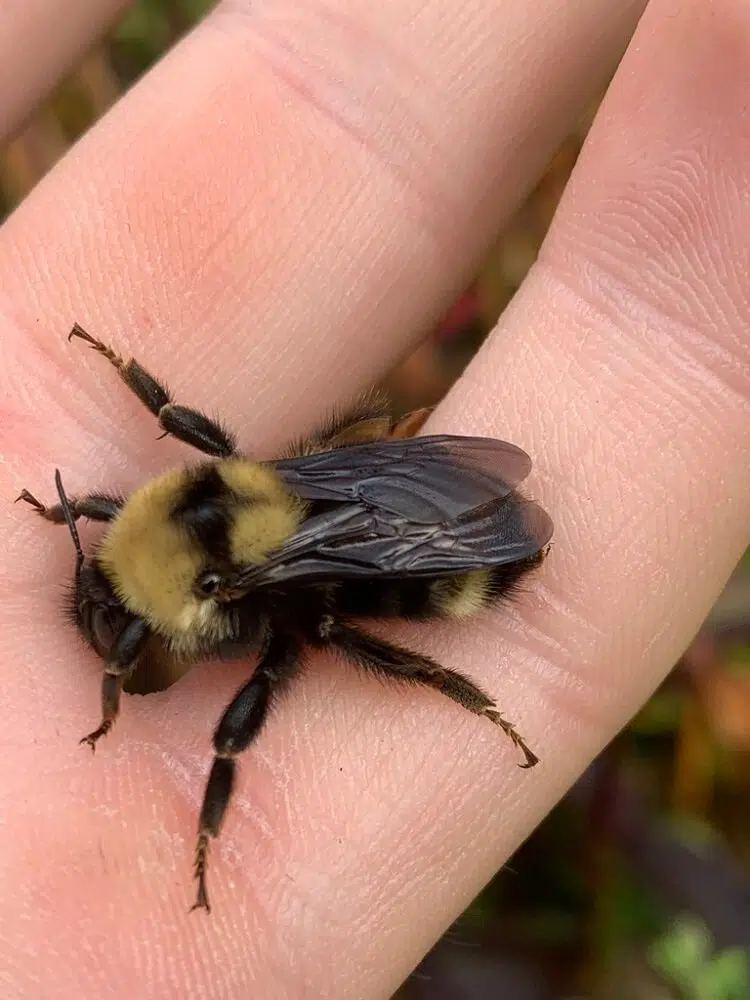
The California Bumble Bee (Bombus californicus) is native to California and parts of Central America. Data on this species is decreasing together with its populations.
It’s estimated more than 60% of these bees have disappeared over the past years. However, it remains an important species that are also easy to recognize.
While it comes in different colors, the California Bumble Bee is mostly black. Identified individuals of the species are certainly black with a yellow stripe on the thorax and a yellow stripe on the abdomen.
The diminishing numbers of the California bee have been associated with decreased pollination benefits.
While known for pollinating a wider range of flowers, the California Bumble Bee is mostly pollinating sage, red clover, and blueberry together with California poppies.
7. Sonoran Bumble Bee

As their name suggests, these bees (Bombus sonorus) are common around the Sonoran desert. They are known as black and yellow furry bees which can grow up to 18mm (even more for queen bees).
They emerge from hibernation or low activity during the winter. These bees nest in the ground, apparently without any type of organization.
The bees dig deep to establish locations to lay eggs. These bees are known for caring for these eggs as their broad eggs provide heat for quick larvae development.
A distinct trait of these bees is that they store honey and pollen separately from the larva and the eggs. Many bumble bees store the eggs directly on the pollen.
Instead, the Sonoran Bumble Bee stores pollen in a dedicated underground chamber. Worker female bees deliver these to the larvae while males guard the nest.
8. Urbane Digger Bee
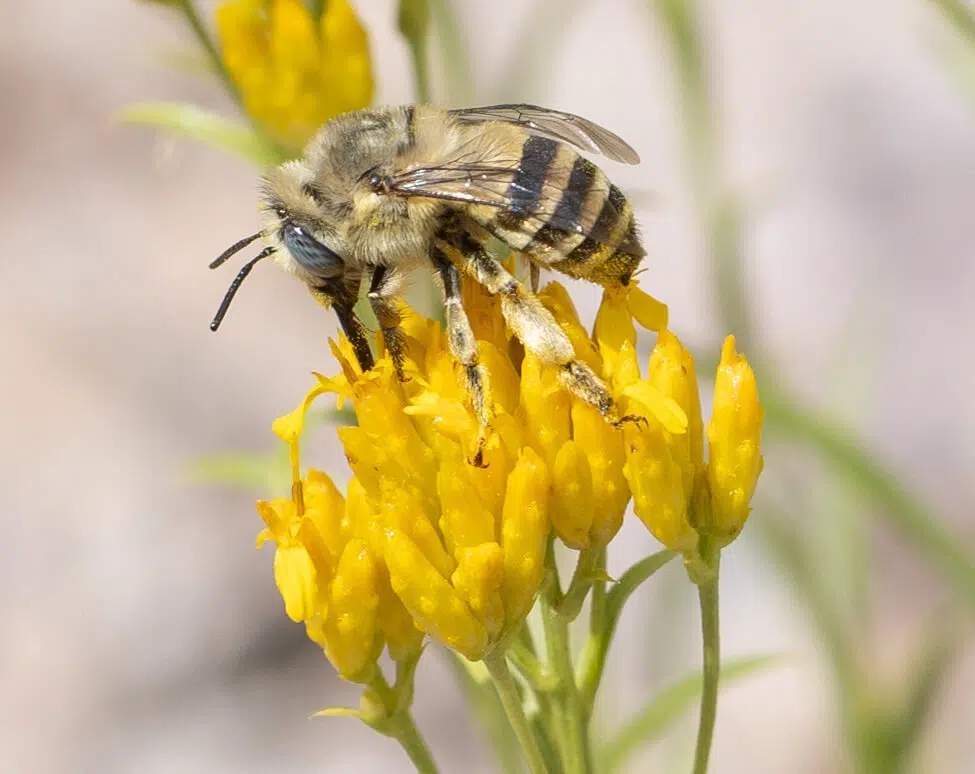
The Urbane Digger Bee (Anthophora urbana) can be recognized by its thick body about other bees. It has a black body with horizontal white stripes.
As its name implies, the species digs for nesting. It finds loose soil to excavate to build underground nests.
These bees are solitary. They are only seen in groups when mating. The Urbane Digger Bee lives a solitary life rarely traveling more than a few miles away from its underground nest to find pollen.
9. Western Carpenter
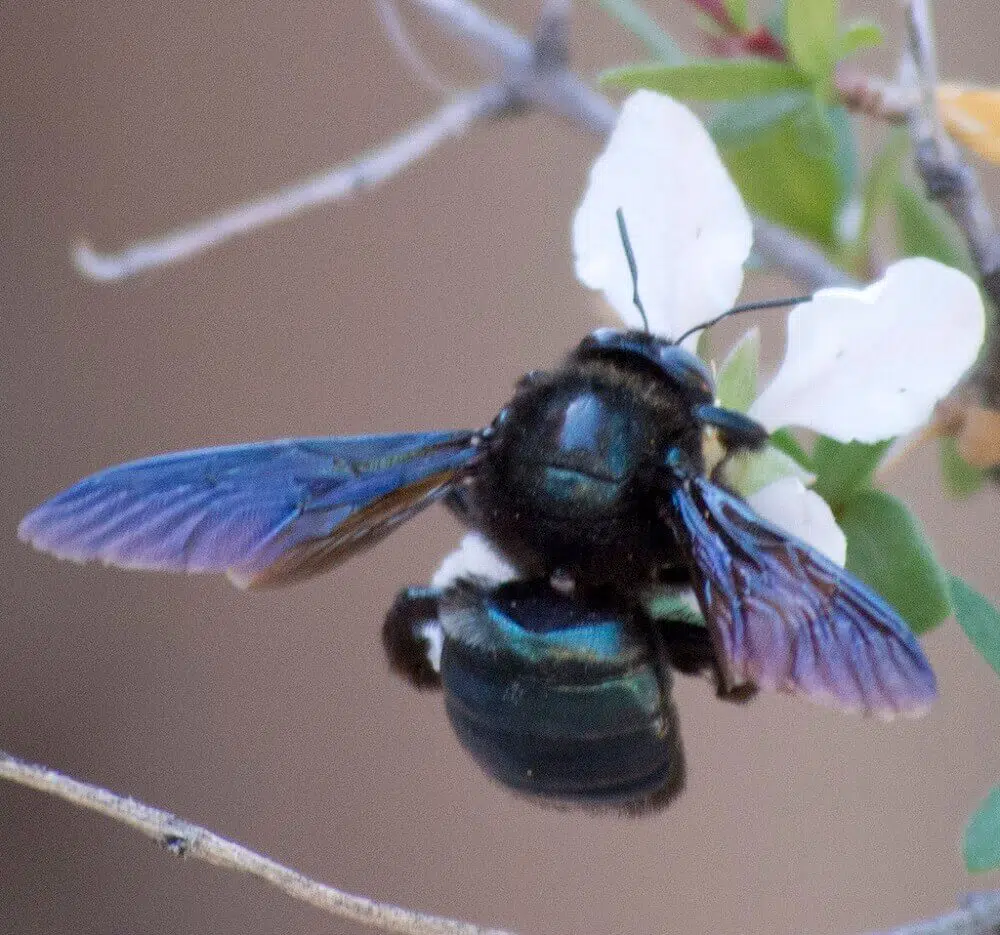
The Western Carpenter bee (Xylocopa californica) is native to Western North American states such as California. It’s also common through the entire Western coast up to Washington state.
The female bee of the species is known for an all-black body with black legs. These hairs have a green or sometimes blue tint.
Males are known for looking similar but they have a few more light-colored hairs on their bodies.
Preferred habitats include woodlands and deserts. It’s here that these bees have a positive role in the pollination of native plants.
Like other carpenter bees, the Western Carpenter Bee is mostly interested in nesting in pieces of deadwood.
Soft wood is preferred for nesting as it’s easy for the bees to chew through with their mandibles.
Nesting is important for this species. Females don’t leave their nests to travel far particularly.
Even when mating, female Western Carpenter bees prefer to use pheromones to attract males, often near the nest.
Females are also the only ones capable of stinging. However, they are rather docile compared to other species. Male Western Carpenter bees don’t have stingers.
10. Wide-striped Sweat Bee
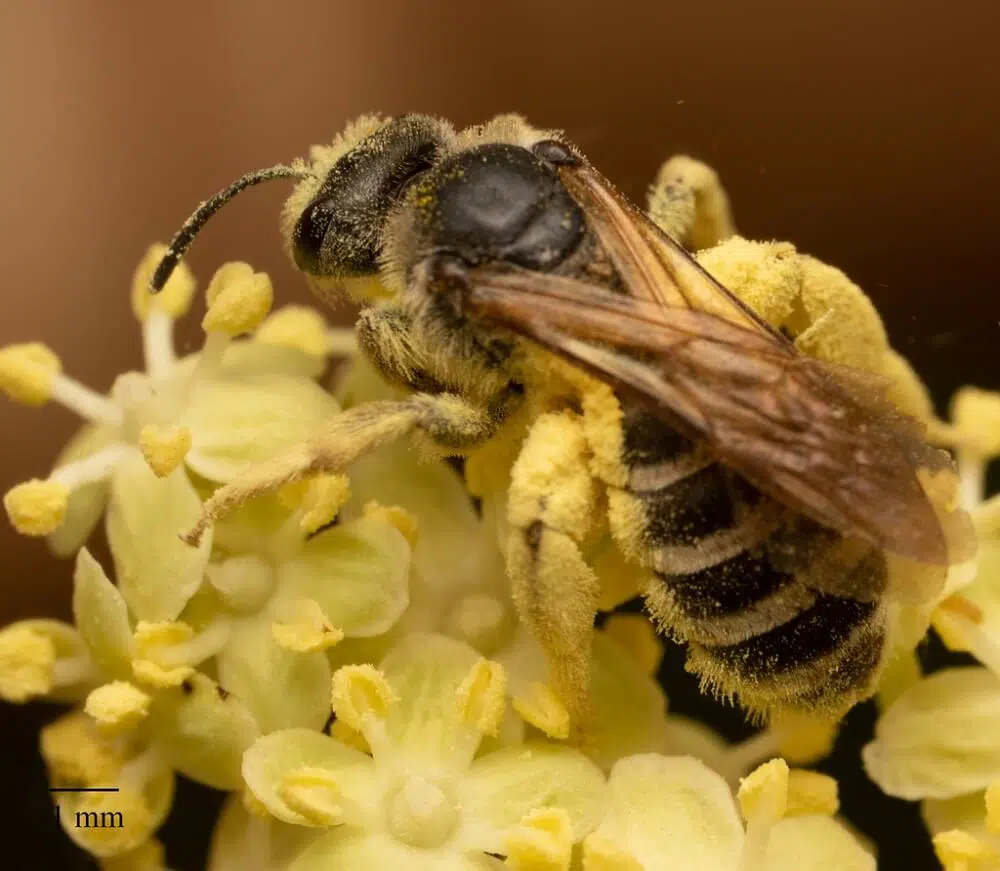
This bee (Halictus farinosus) is native to Southe-Western states such as California. It can be found in high numbers on white flowers around the state.
The Wide-stripped Sweat Bee gets its name from the white stripes that run parallel to each other from the back of the head to the abdomen.
Wide-striped Sweat bees can be further differentiated from other species by their bright yellow legs.
A very long flight season also characterizes these bees. They can be seen in late February continuing to remain active until early fall.
11. Peridot Sweat Bee
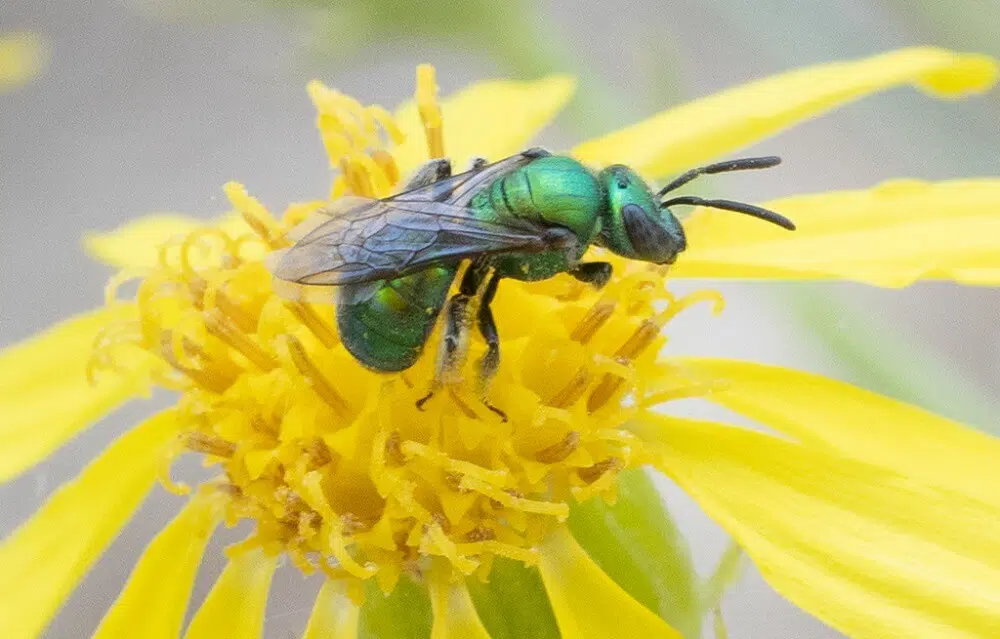
These bees (Augochlorella pomoniella) are common throughout the state. They are known for metallic colors with tints of green, blue, or red. Most bees found in California have a green metallic color.
Peridot Sweat bees live in the ground. They purposefully seek out the softest ground to excavate as they build complex nests with multiple underground chambers.
The entrance to these nests is a bit wider than the entrance of nests built by other species, mainly to allow easy food transportation.
Female Peridot Sweat bees collect pollen in rolled balls. These balls of pollen are then rolled inside the nest in individual chambers to serve as larvae food.
While not known for living as much as Wide-striped Sweat bees, the Peridot Sweat Bee still lives from April to September.
12. European Woolcarder Bee
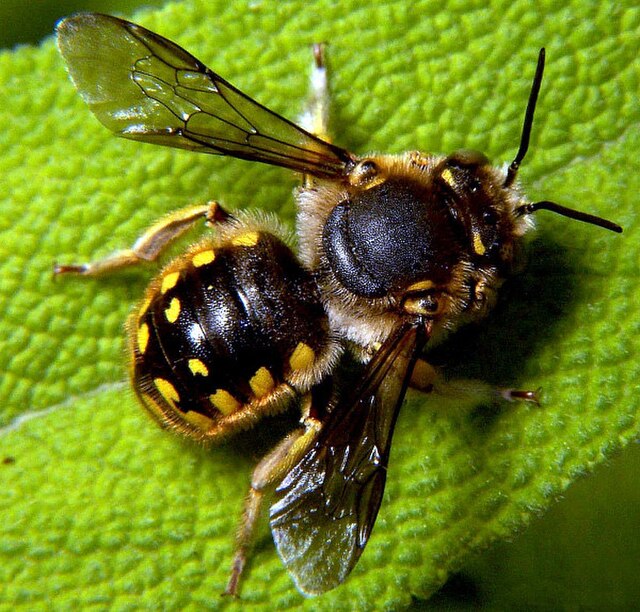
These bees (Anthidium manicatum) are known for having bulbous body shapes. They are black with partial yellow strips interrupted in the middle of the abdomen and thorax.
European Woolcarder bees get their name from scraping hairs out of soft plants such as lamb’s ears.
These bees have been accidentally introduced to California and the rest of the country.
While not particularly aggressive towards other species, the European Woolcarder Bee is highly aggressive within its species.
Males fight for territorial dominance which results in mating success or failure.
Males of the European Woolcarder species are part of sexual dimorphism where they are larger than females, unlike in other bee species.
Smaller male bees often have to resort to alternate mating strategies. The larger the male bee is the more it exerts its dominance in a certain territory, essentially mating with more female bees.
The females of these species also show characters of polyandry. It means they often mate with multiple males turning from one male to another fast.
Males are often put off by this behavior and they use territorial defense strategies to behave as if certain flowers are their own in an effort to keep the female bee from having as many male mates as possible.
13. Crotch’s Bumble Bee

This species (Bombus crotchii) has been named after the entomologist who discovered it, George R. Crotch. It’s now an endangered species due to its limitations of living in very specific conditions.
The Crotch’s Bumble Bee is a species that lives in California mainly due to the warm weather here.
It feeds on a variety of plants such as those of the milkweed family.
This species nests underground. Preferred nests include existing cavities which often include the holes made by rodents.
The remaining bees are mostly found in the driest areas of the state as this is the only habitat it feels fully comfortable in.
This species is known to nest in the ground, in parts of California. Some reports also see South Nevada as another habitat of the species. However, all Crotch’s Bumble Bee studies are centered around its presence in California.
Crotch’s Bumble Bee faces extinction. It’s now seen as an endangered species. While it might not be completely extinct over the next few years, its numbers are diminishing.
The Crotch’s Bumble Bee is one of 3 protected bee species in California.
One of the reasons for its protection is climate change, which is believed to impact its habitat. Once very common in the Central Valley of California, this bee is not less common than it used to be.
14. Bindweed Turret Bee

The Bindweed Turret Bee (Diadasia bituberculata) also prefers hot climates like the Crotch’s Bumble Bee. This species lives in the ground where it digs solitary nests.
While solitary, these bees dig their nests just inches away from each other. They prefer to live in natural habitats away from urban environments.
Females dig these nests without any help. Once the nests are ready they proceed to collect pollen from various flowers to later deposit in the nest.
15. Western Leafcutter
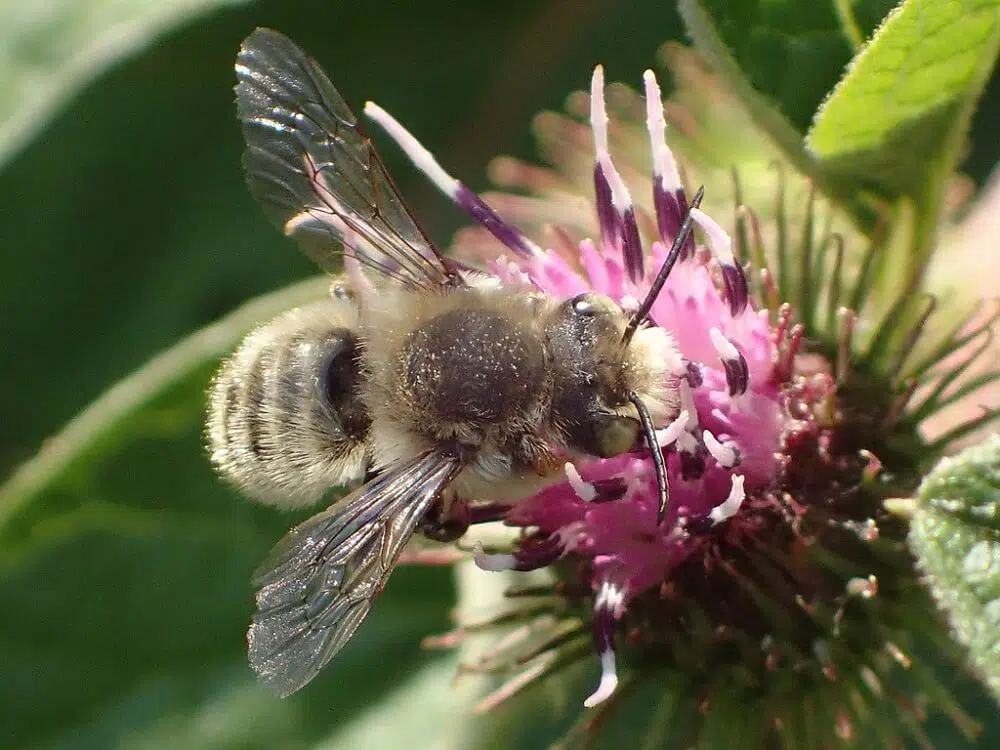
The Western Leafcutter species (Megachile perihirta) is recognized by its yellow-white thorax and abdomen.
Both nectar and pollen are seen as the ideal food for the species. However, there’s a difference in the food these bees consume depending on their development stage.
Young bees eat both pollen and nectar while adult bees only eat nectar.
Unlike other bee species in California, the Western Leafcutter bee builds nests in groups, not individually.
Multiple bees work to dig a nest in the ground or decaying wood. These nests are often comprised of multiple chambers.
Leaf and vegetation fibers are used to create individual chambers inside the nest. Pollen and nectar are used as a feeding source for larvae in these chambers.
16. California Mountain-Digger Bee
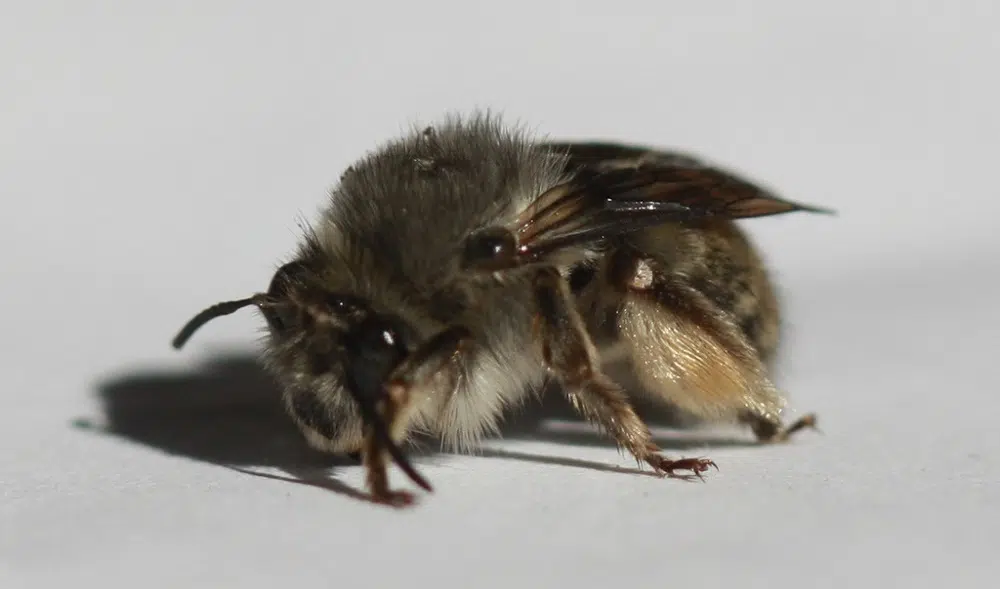
The California Mountain-Digger Bee (Habropoda depressa) is one of the hundreds of native species of California bees. These bees live solitary lives which is why they aren’t studied extensively as they can’t easily be found.
Even if they live in gardens and urban areas, Californian Mountain-Digger bees are generally living in smaller groups.
They can be identified by a gray body with white markings. Its fuzzy body makes it stand out compared to all other native Californian bees.
Its wings are brown while its veins are black.
17. California Digger Bee
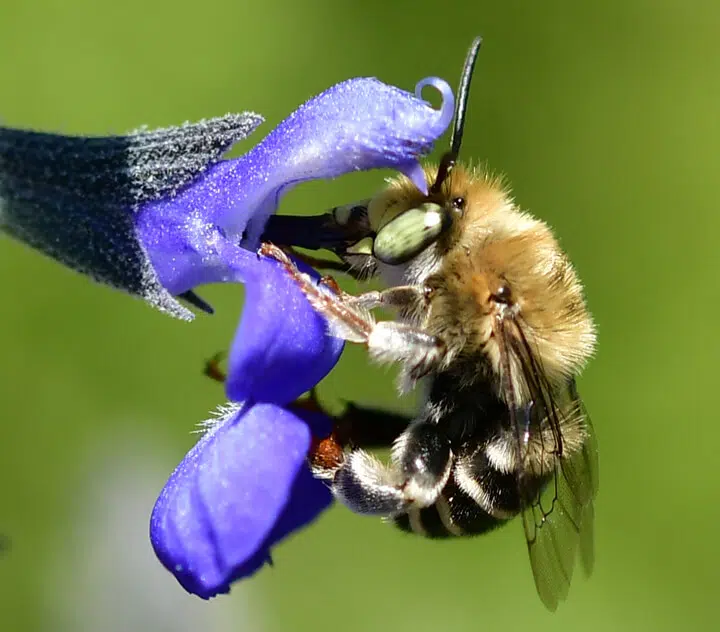
These native Californian bees (Anthophora californica) are also common in parts of Central America. While gray, they have distinct yellow coloring on the thorax.
These bees can be further identified by their red-brown legs coloring.
Studies show these bees have a very specific flight pattern as well. They fly directly towards a flower and then stop just in front of the flower and hover for a few seconds to examine them.
The species is known for its underground nesting abilities.
California Digger Bees always nest alone but next to other underground nests. Up to a few thousand bees are often seen in one area.
Female California Digger bees use their front legs to excavate nests in the loose ground which serve as protection for their eggs and pollen.
These bees are largely unknown outside California. People aren’t aware of them in the rest of the country.
However, they are seen as docile bees that don’t sting. They might only sting when provoked.
These bees are known for preferred cleared soil to nest, especially soil free of debris or mulch which is easy to dig into.
Activity is high in the summer around these nests. Bees provision these nets with pollen and nectar.
Some bees have also been shown to survive winter in these nests. They remain dormant until spring in these nests.
18. Van Dyke’s Bumble Bee

These bees (Bombus vandykei) are part of the large Apidae family. They live all across North America with a high presence among Californian bees.
They are often overlooked as they only live in arid areas away from urban settlements.
A bright yellow body with only a few faded black stripes characterizes the look of these bees.
While not completely confirmed all across the country, the males of these species are mostly yellow and they have fewer black lines and coloring compared to the females.
19. Honey-tailed Striped Sweat Bee
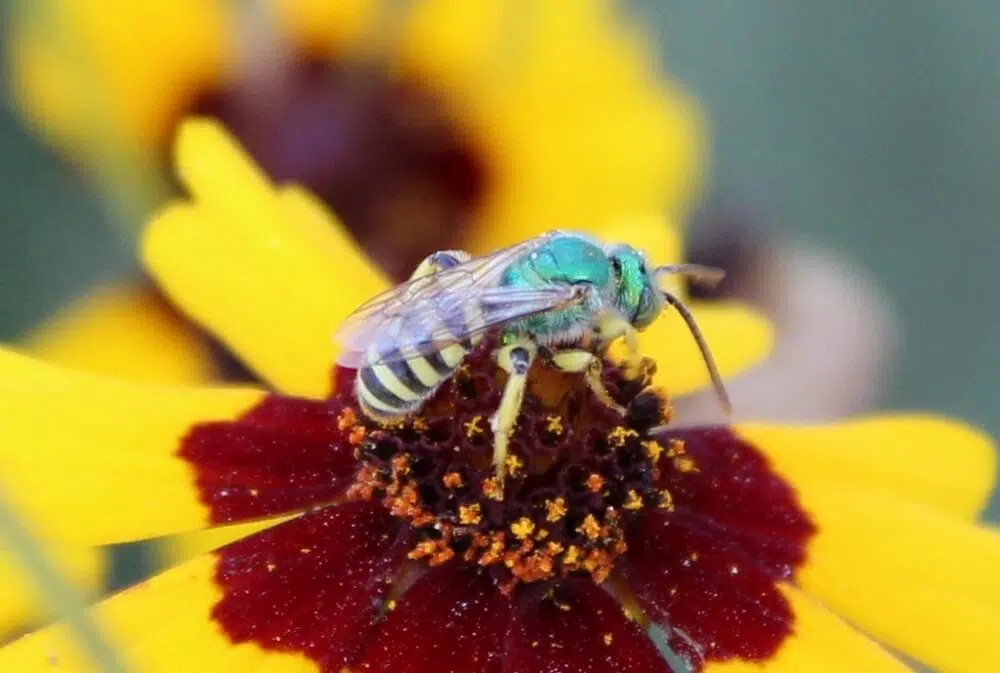
The Honey-tailed Striped Sweat Bee (Agapostemon melliventris) is known for having an abdomen that resembles the abdomen of honey bees.
It has a bright green thorax and a black abdomen with yellow stripes.
These bees live all across North America. However, higher numbers are reported in Southern states such as California, Arizona, and Texas, together with colonies in Central America.
Mating is one of the distinct traits of these bees. Male bees often fly in groups in front of prospective female mates.
Female bees then get to choose the males they want to mate with simply by comparing physical characteristics out of a group.
20. Pruinose Squash Bee
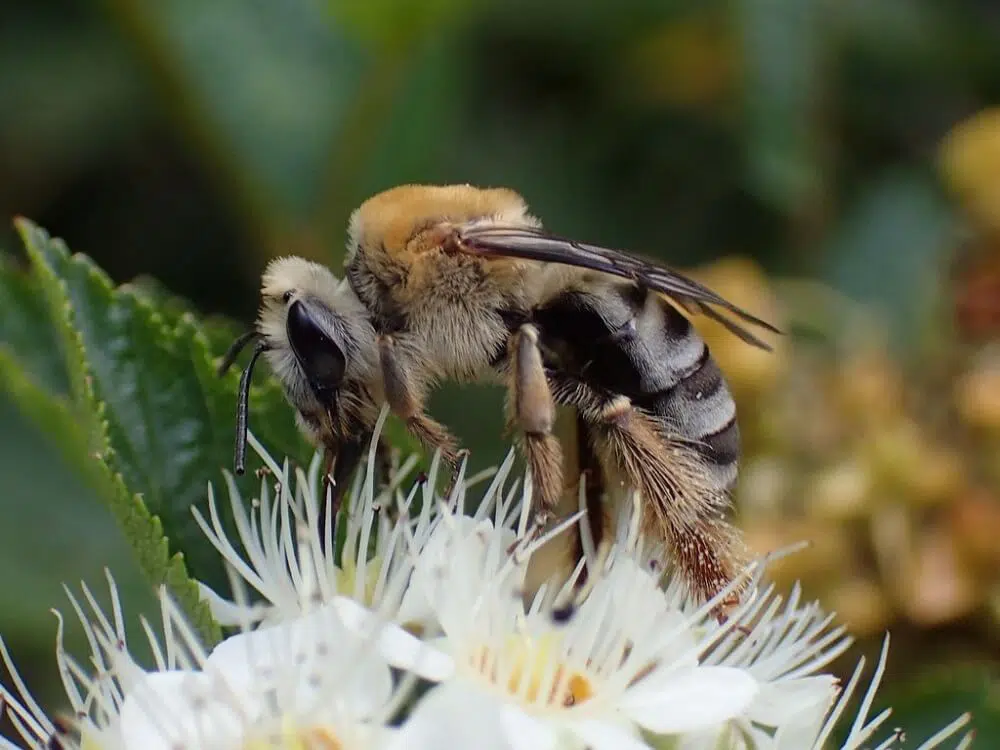
This bee (Peponapis pruinosa) is commonly seen around squash and pumpkin. It’s one of the most important squash pollinators in the state.
The Pruinose Squash bee has a busy lifestyle. It always forages early in the morning where squash flowers open.
It never builds or repairs nests early in the morning as this is an activity mainly settled for later in the day.
Some incipient data also shows the bee adapts well in-ground cleared by fire. Otherwise, it simply builds underground nests straight next to squash.
21. California Digger-cuckoo Bee
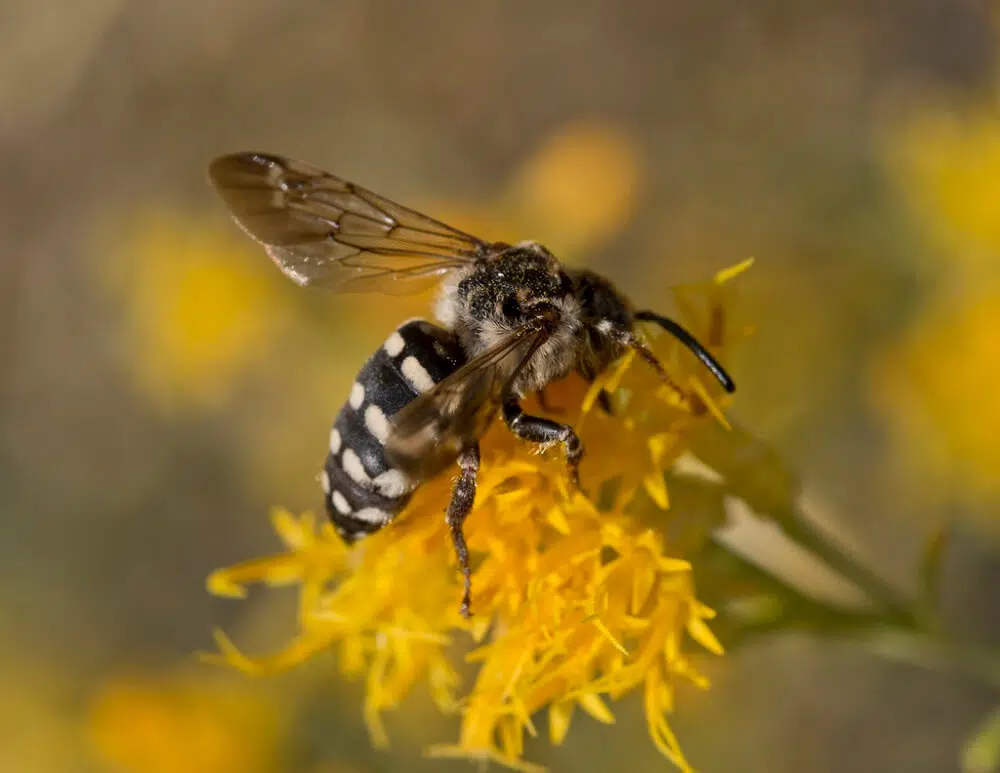
The California Digger-cuckoo Bee (Brachymelecta californica) was once considered very rare. It turns out this species is cleptoparasitic.
The female California Digger-cuckoo Bee is known for laying eggs in the nests of other digger bees in California.
It kills the eggs or larva found inside underground nests to lay its eggs.
22. Megachile fidelis
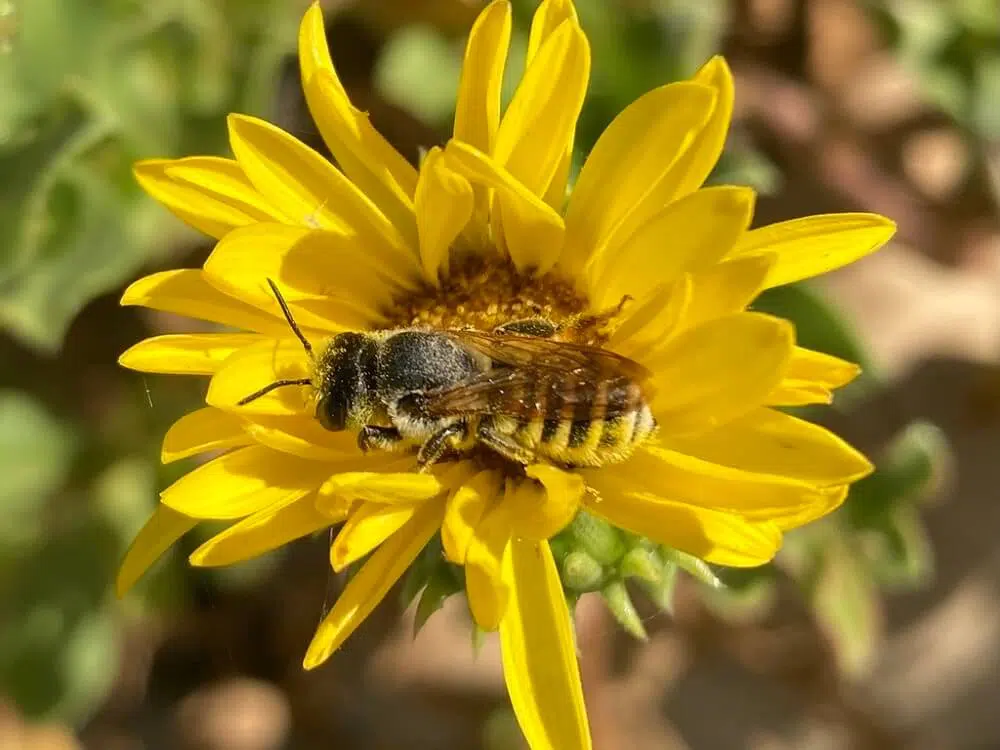
This species is identified by an all-black body. Male bees of the species are known for also having bright-colored hairs.
It collects pollen which it uses to feed itself and its offspring.
This species of leafcutter bees nests underground or in cavities. It often uses vegetation to create separation within the nest.
23. Hunt’s Bumble Bee

The species (Bombus huntii) is known for its black, white, and red body coloring. It has been categorized as an endangered species albeit it’s still common in the Western US.
Hunt’s Bumble bee is a common pollinator of rabbitbrush and thistles.
It also lives around pine forests commonly. Since California has a shortage of tomato pollinators there have been a few experiments on the Hunt’s Bumble Bee.
It turns out this species can be adapted as an efficient tomato pollinator in the state.
24. Cherry Plum Mining Bee
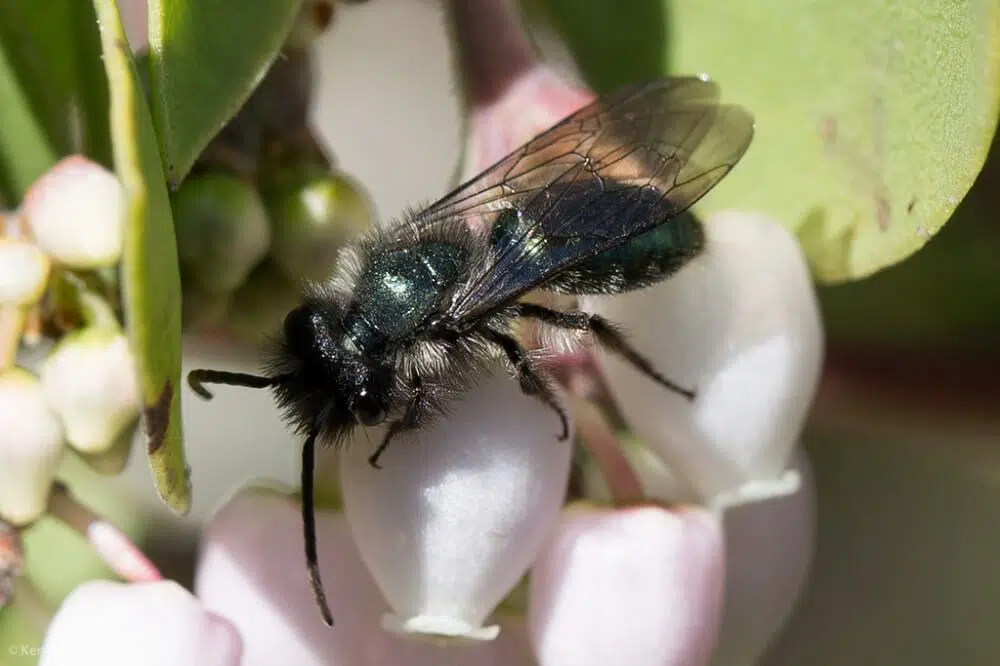
The Cherry Plum Mining Bee (Andrena cerasifolii) is common in parts of California. It emerges early in the spring and lives until mid-summer.
Cherry Plum Mining bees are known for pollinating Cherry Plum trees. The blossom of these trees is invaded by the species in early spring.
To minimize the flight time from the nest to the tree blossom, Chery Plum Mining bees nest right next to the trees.
25. Suave Nomad Bee
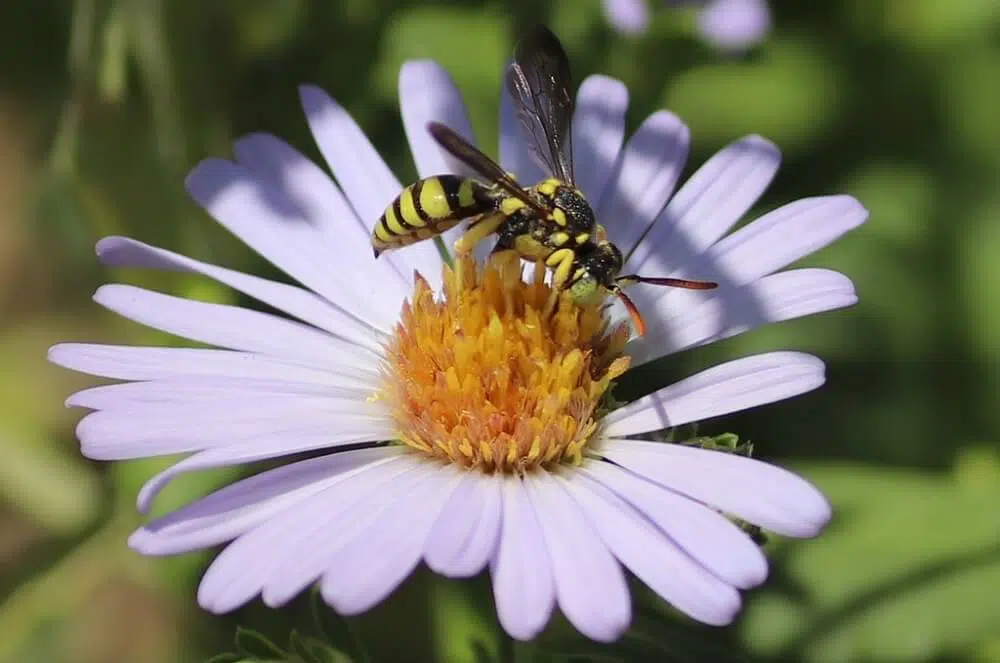
These bees (Nomada suavis) are cleptoparasitic. They cannot collect pollen or they have poor pollen-collection capacity since they don’t have hairs on their bodies.
They can be recognized by their very thin thorax and yellow-black striped abdomen. Suave Nomad bees are known to be a parasite to many Californian pollen-collecting species.
Without a capacity to collect pollen, the Suave Nomad Bee nests inside existing underground bee nests where they can find pollen. They kill all larvae and bees found here.
26. Yellow-Fronted Bumble Bee

Asteraceae flowers are the main food source and pollinator for the Yellow-fronted Bumble Bee (Bombus flavifrons). These bees are known for their beneficial pollination role in late spring and through the summer.
Queen Yellow-fronted Bumble bees appear in late March. The first worker bees follow a month after.
They continue to consume pollen and pollinate flowers until late August. Only a few queen bees of the species survive.
The remaining queens enter a state similar to hibernation until the following season.
This species has multiple natural predators. Among them, the Bombus insularis cuckoo bumble bees are the most prevalent danger.
27. Vancouver Bumble Bee
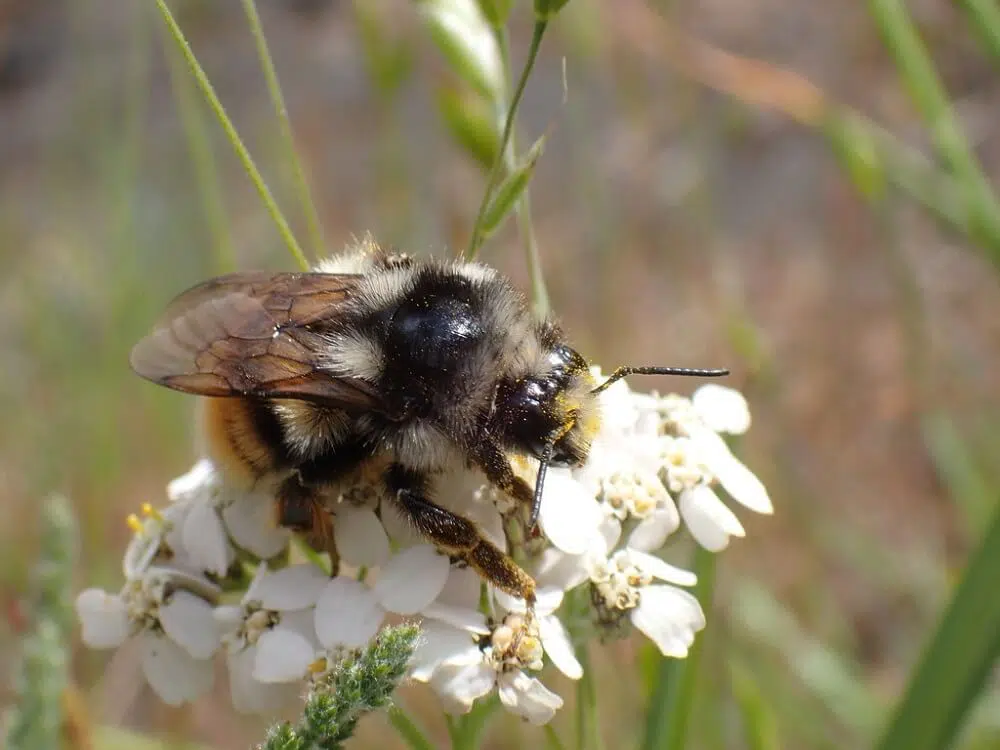
These bees (Bombus vancouverensis) are some of the most common on the West Coast. They are found in large numbers from Alaska to California.
As known pollinators, the bees are commonly seen around flowers such as aster and cirsium. It was once believed the species had good navigation skills to find these flowers.
It turns out the Vancouver Bumble Bee has very poor orientation skills. It rarely comes back or it rarely remembers the location of a certain aster.
These bees are commonly seen above the ground, even if they also nest in the ground.
A typical Vancouver Bumble bee nest is made from a single small above-ground chamber.
Up to 5 waves of worker bees emerge from these nests once established by queen bees.
28. Fuzzy-Horned Bumble Bee

Most Fuzzy-Horned Bumble Bees (Bombus mixtus) are found in high elevations of the state. These are tri-colored bees dominated by bright-colored fuzzy hairs.
They are known to prefer ceanothus and fireweed flowers.
Like the Vancouver Bumble Bee, the Fuzzy-Horned Bumble Bee has the skills to nest both underground and above the ground.
29. Rhus Fairy Bee
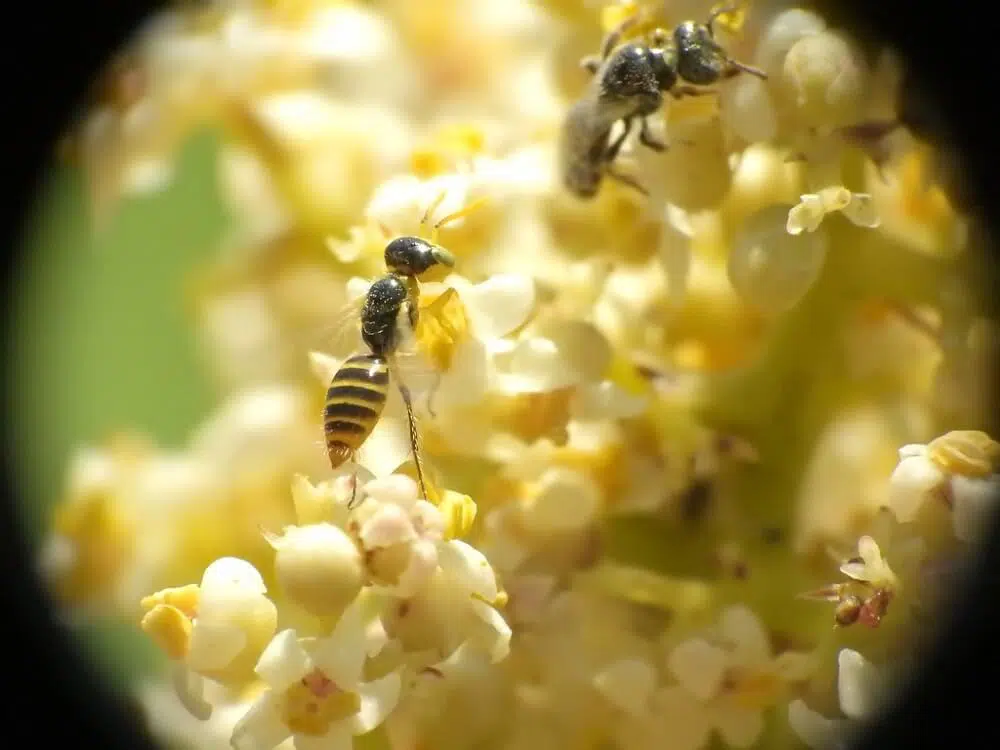
This bee species (Perdita rhois) is common in California, Southern United States, and Mexico.
It’s identified by a resembled the Western Honey Bee with its black and yellow body.
The bee has a blackhead, a black thorax, and a black abdomen with yellow stripes. Its antennas are yellow and its feet are also yellow.
This species is prevalent in California where it finds its favorite flowers. Rhus Fairy Bees are mostly interested in the Adenostoma genus, a rose of the Rosaceae family.
Adenostoma flowers are common in California and Baja California.
30. Lasioglossum ovaliceps
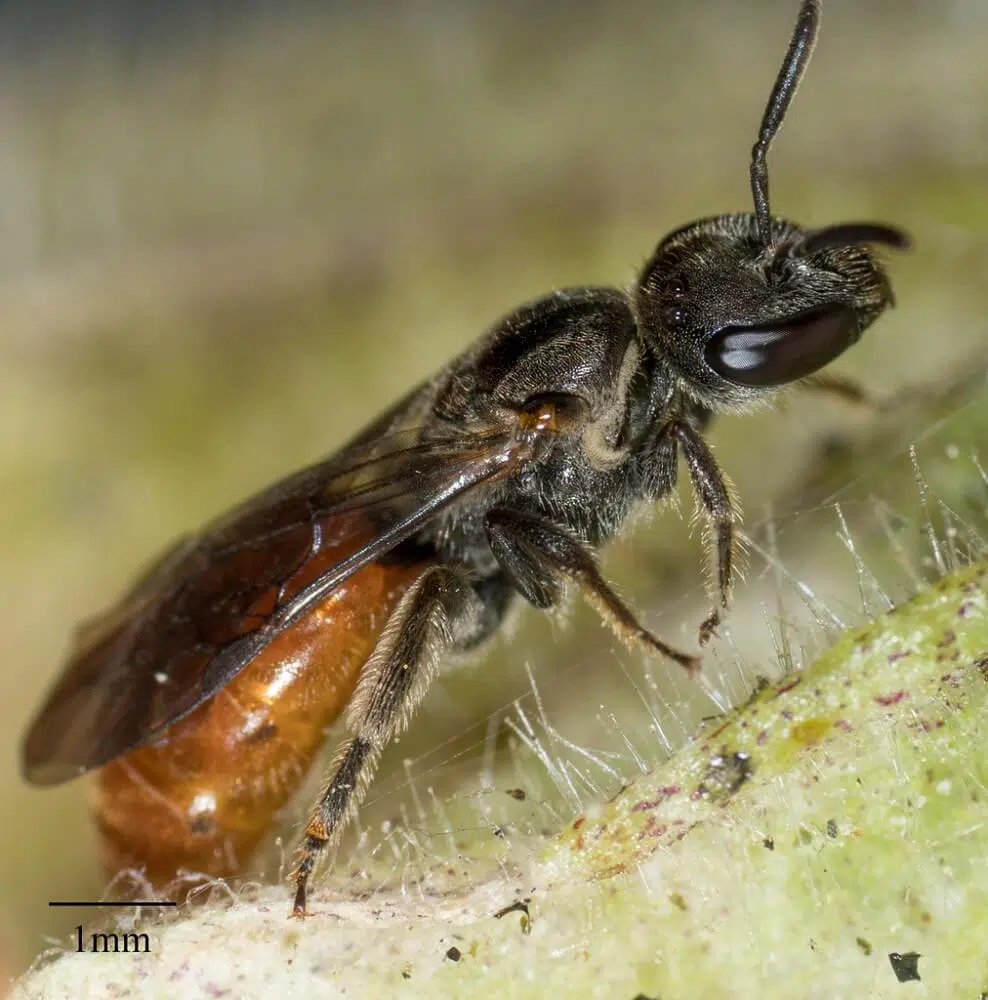
This bee (Hemihalictus sensu lato) is known for its all-black body. It can sometimes have a red or orange band around its thorax.
The species is a known pollinator in California as well as across the Western coast.
Further Reading: